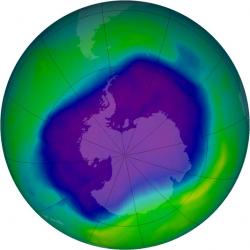Greenland Ice Sheet on a Downward Slide
For the first time NASA scientists have analyzed data from direct, detailed satellite measurements to show that ice losses now far surpass ice gains in the shrinking Greenland ice sheet.
"With this new analysis we observe dramatic ice mass losses concentrated in the low-elevation coastal regions, with nearly half of the loss coming from southeast Greenland," said lead author Scott Luthcke of NASA Goddard's Planetary Geodynamics Laboratory. "In the 1990's the ice was very close to balance with gains at about the same level as losses. That situation has now changed significantly, with an annual net loss of ice equal to nearly six years of average water flow from the
NASA and NOAA Announce Ozone Hole is a Double Record Breaker
NASA and National Oceanic and Atmospheric Administration (NOAA) scientists report this year's ozone hole in the polar region of the Southern Hemisphere has broken records for area and depth.
The ozone layer acts to protect life on Earth by blocking harmful ultraviolet rays from the sun. The "ozone hole" is a severe depletion of the ozone layer high above
Expect a Warmer, Wetter World this Century
Recent episodes of deadly heat in the United States and Europe, long dry spells across the U.S. West, and heavy bursts of rain and snow across much of North America and Eurasia hint at longer-term changes to come, according to a new study based on several of the world's most advanced climate models. Much of the world will face an enhanced risk of heat waves, intense precipitation, and other weather extremes, conclude scientists from the National Center for Atmospheric Research (NCAR), Texas Tech University, and Australia's Bureau of Meteorology Research Centre. The new study, "Going to the Extremes," will appear in the December issue of the journal Climatic Change.
Find blog posts, photos, events and more off-site about:
Canada, Conservatives, Government, parliament, politics, Ambrose, Environment, Minister, resign, activism,
MP's, Ottawa, Kyoto, green, green=plan, Vancouver, B.C., smong, air-pollution, Mulroney, acid-rain, greenhousegas,
Ozone,
Antarctica, CF, flourocarbons, sun,
Greenland, ice, NASA, NOFA

No comments:
Post a Comment